Imagine that your sales pipeline is a slide at a waterpark; your leads sit on it, begin as prospects and land up as customers. Unfortunately, this slide isn’t always a smooth ride for all the leads. It may have a lot of bends or break midway towards conversions.
While it might look like a safety hazard at the waterpark, it’s often the case in a sales workflow. The sales pipeline either gets stuck at a particular stage or begins to lose leads before they convert.
This guide has got all the tips you need to build and manage an effective sales pipeline.
What is a Sales Pipeline?
A sales pipeline is a sequence of well-defined sales processes a lead goes through before turning into a customer. It helps you visualize where your customers are in the process and analyze how you can move them to the next stage.
Why do you need to visualize your sales pipeline?
- Measure sales performance for the team and individuals
- Set quarterly/yearly sales quotas
- Predict accurate sales revenue
- Track sales progress
- Improve resource management
You might wonder how a sales pipeline differs from a sales funnel. Well, many people believe that they’re the same and even use the term interchangeably. However, that’s not the case.
The biggest difference that sets them apart is that the leads in a sales pipeline have a much higher potential to convert into a customer. Whereas a sales funnel may have many leads who have an interest in your product but can’t turn into customers.
Sales Pipeline vs. Sales Funnel
Here are a few ways in which the sales pipeline and sales funnel differ:
Sales Pipeline | Sales Funnel | |
Focus On | Seller’s Journey: A sales pipeline is business and sales oriented. The focus is on gaining more customers. | Buyer’s Journey: A customer-oriented sales funnel segments customers based on awareness and buying intent. |
Conversion | Most of the prospects in a sales pipeline have the potential to convert into customers. | Not all prospects in the sales funnel convert into customers. |
Used by | Sales managers and salespeople to move prospects along in the journey. | The marketing and sales strategy team moves leads across sales processes. |
Analyzes | Sales Efficiency, sales performance, and sales velocity. | Marketing efforts, market segments to focus on, and the stages in the sales process that need to be improved. |
Predicts | Deal volume, deal size, potential revenue, and ability to meet sales quota. | Sales forecasts, conversion rates, and customer engagement. |
Tools used to optimize | CRM, sales analytics tool, and sales pipeline management software. | Marketing Automation Software, Google Analytics, Social media analytics tools. |
A better way to understand this is to imagine that there’s a sales funnel with a long pipe-like end. The leads which are filtered by the sales funnel move into this pipe, the sales pipeline.
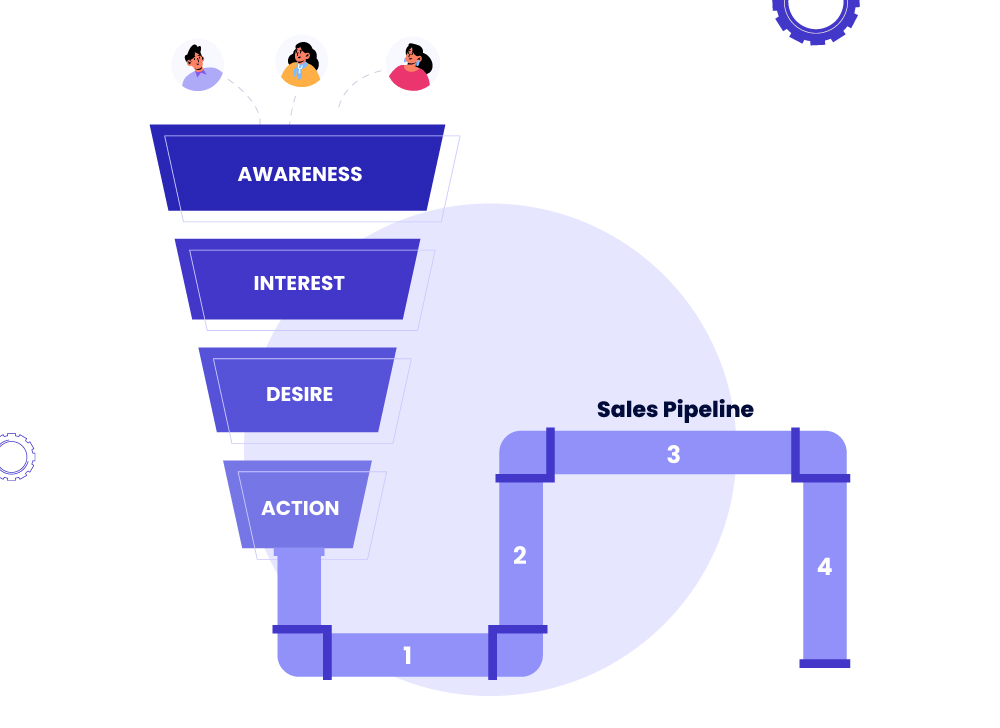
Businesses benefit from analyzing both—the sales pipeline and the sales funnel. Understanding and visualizing both these aspects help boost sales performance.
But before you crack your sales revenue targets, you need to build a solid and effective sales pipeline. Let’s simplify it by breaking it down into the different stages in a sales pipeline.
6 Stages of a Sales Pipeline
The sales cycles across industries may vary, but the selling stages are mostly the same. Your leads move through these stages, and the sales team needs to ensure continuous lead flow. Any blockers or slow sales velocity spells trouble for your revenue.
The sales pipeline stages can be abbreviated as SPANCO, coined by Xerox for the sales community. SPANCO stands for Suspect, Prospect, Analysis, Negotiation, Closing, and Order. It’s essential for salespeople to understand which stage your lead is at, along with the intricacies of the stage.

1. Suspect
At this stage, you have a long list of leads with some interest in your product/service. These leads may be generated from marketing activities, your personal contacts, or companies that you potentially want to focus on. The biggest challenge here is the high volume of leads for every salesperson.
To improve sales productivity, filter out these leads and work on the ones with a higher buying intent first. You can use a CRM platform lead scoring and create buyer personas to map suspects against.
2. Prospect
Technically, leads with a higher buying intent are your prospects.
Based on the kind of business, choose a medium to make the first contact with a lead. You can look at the historical data to determine the most effective channel of communication.
In general, prospects are open to connecting with salespeople via LinkedIn (21%), SMS (21%), social media (18%), and in-person at industry events (34%). The other channels that salespeople utilize are phone and email.
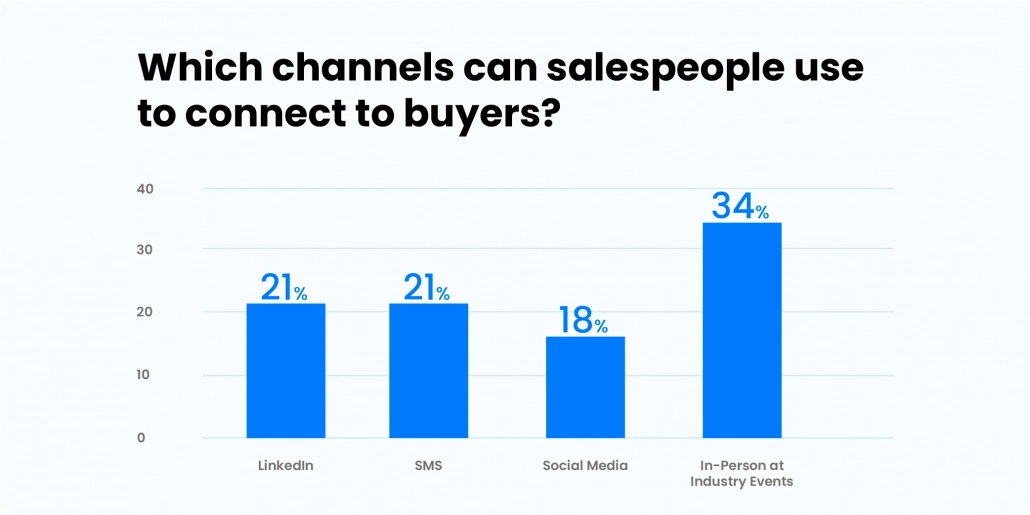
3. Analyze
Before pitching your product/service, it’s important to understand your prospect’s buying potential. A discovery call helps here.
Try to understand the root cause of their problems before you begin talking about your product. This call isn’t even a sales pitch. It’s to ensure the buyer could trust you as an advisor rather than a salesperson, which is what over 88% of buyers prefer.
This stage involves multiple follow-ups and talking to various hierarchies in the business based on the deal size. The important point is your team should be enabled with the right resources and tools. It will help move things faster.
Finally, you’re all set to share a tailor-made sales pitch through a demo, sales presentation, or site visit. The pitch must address all the prospect’s doubts, challenges, and objections. It’s a chance for you to prove why they should go with you instead of the competitors.
And then comes the hard part, waiting for them to decide.
4. Negotiate
A novice salesperson may feel that a yes or no from the buyer is the end of the deal. But a seasoned one can gauge the buying intent and reason out any objections that come in the way.
At this stage, the customer wants to take the deal ahead but not be wholly convinced to. If this step isn’t tackled in the right manner, all your efforts so far may go in vain. The negotiation may seem monetary or feature-based, but it all boils down to the ROI. Use social proof or offer discounts and free trial to speed up the process.
Here’s a free resource for your team: Guide To Overcoming 21 Most Common Sales Objections
5. Close
Finally, a big sigh of relief. Your prospect turns into a customer at this stage as they agree to the deal. Now, all you have to do is share closing documents to sign and ensure that the buyer agrees to the terms of the deal, the price, and the deadlines for delivery/implementation.
You can use these closing techniques: 15 Smart Sales Closing Techniques [Scripts and Examples] to encourage your buyer to complete the purchase and move to the next step.
6. Order
The interesting part of a sales pipeline is that it doesn’t culminate at just conversion. Retention is a significant part of selling too. Now’s the time for you to hold up your end of the bargain and provide the seamless product experience that was offered to the customer.
Whether it’s implementation or product delivery, you must ensure that your team completes the process on time. As the buyer’s only point of contact, you can help the buyer out wherever it’s required. A few months down the line, this stage is also relevant for you to collect reviews and feedback on the product and sales process. This feedback will help you improve the way you sell!
The SPANCO pipeline works for most businesses, but if your product/service requires the buyer to change the way they do business or focus on only highly qualified buyers, you can implement the MEDDIC process instead.
Read: MEDDIC Sales Process Explained! to know more about the MEDDIC process.
Now that you better understand the sales pipeline process, you can begin to define the exact processes in your sales cycle.
Along with the stages, a couple of other variables need to consider while building your sales pipeline.
How to Build a Sales Pipeline?
The sales process stages are benchmarks in the pipeline, aiming to ensure that your leads move through it as soon as possible. To track sales performance and predict revenue, you need to:
1. Track progress at each sales stage
Two metrics that help you measure progress in the sales process are:
- Time spent at each sales stage
- Percentage of conversion
Over time, recording and visualizing this data on your CRM, or other pipeline management tools, can help you set standards to predict what the sales pipeline looks like.
If you’re looking for a CRM tool that helps you manage your sales pipeline and visualize sales data, here’s a guide to help you make the right decision!

Businesses that operate in multiple industries can set industry-wise standards to predict pipeline bottlenecks and overall revenue. For example, if the deal is at the closure stage and the lead age is three weeks, your salesperson can alter his approach or use the appropriate sales tools to nudge the closure.
2. Set sales pipeline goals
Your sales pipeline and quotas are directly related. The pipeline determines your forecasts which in turn help you set sales quotas. Once you have the yearly and monthly quotas for each sales rep in hand, you need to backtrack them to the pipeline once again.
Doing so helps you break down your targets into achievable milestones. For example, a sales target of $20,000 can be broken down into 20 deals of $1,000 each. Back calculated, it results in 150 suspects, 100 prospects, 70 at the analysis stage, and 40 and 20 at negotiation and closure, respectively. If this ratio of leads is always maintained, your pipeline won’t run dry at any given point.
3. Don’t let leads stagnate
“When it comes to pipeline stages, if the opportunity is stuck at a particular stage, the outcome won’t be desirable. Adding leads frequently only works when you have a good number of leads exiting the pipelines and moving across the stages.”
Raghvendra Tripathi, Senior Vice President (Head of Asia), LeadSquared
The leads cannot stay at the same stage for long because they won’t lead to conversions. They’ll also set off your forecasts and set an unrealistic standard for quotas.
4. Track, record, and analyse sales pipeline metrics
Sales goals change over time, new products are introduced, or maybe there will be a new target industry to focus on. You can’t afford to stick to sales pipelines with so many uncertainties. Those need to adapt to your business objectives too.
To change or update your sales pipeline, you first need an in-depth idea of the ground reality. A sales management tool helps you track and record pipeline metrics. LeadSquared’s Sales Pipeline Dashboard helps sales managers track sales performance KPIs and the sales stages that the customers are at, among many other parameters.
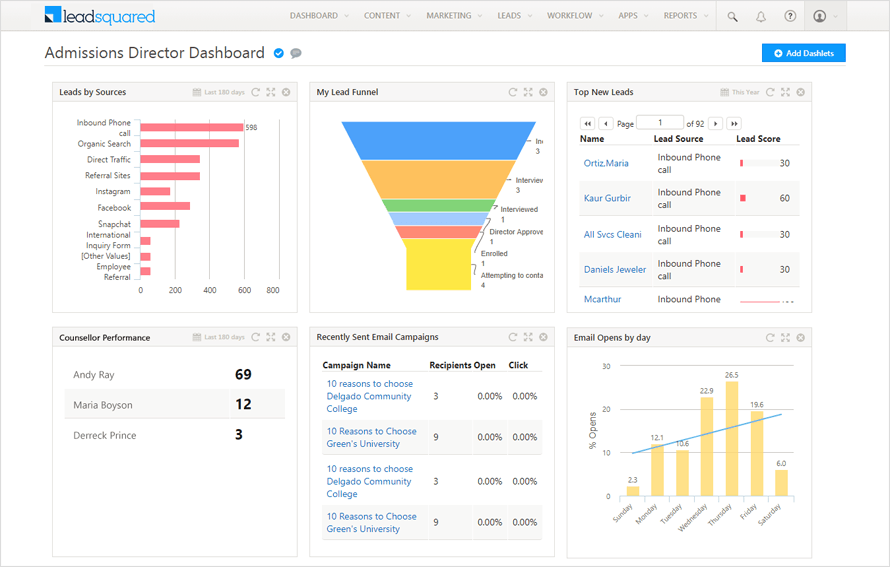
Here are a few sales pipeline metrics that help you determine what slows down conversions and what you can do to speed it up:
- Conversion rate by sales funnel stage
- Pipeline to conversions ratio
- Weighted value of pipeline (Weighted value = Probability of Closing x Deal Value, where the probability depends on the stage of the pipeline, such as 50% for the negotiation stage)
- Sales Pipeline Velocity (Sales Pipeline velocity= (Number of deals in pipeline x Average deal size) ÷ Average sales cycle length)
- Pipeline Coverage (Number of opportunities in pipeline for given period ÷ quota period)
- Deal Drop-off by Stage
- Sales Rep Pipeline Performance
A few techniques can help you improve the outputs from your sales pipeline. These techniques optimize revenue and decrease the length of sales cycle. They fall under the umbrella of sales pipeline management.
How to Manage Your Sales Pipeline?
Sales pipeline management is the process of continuously improving a business’s sales pipeline and sales team performance. It utilizes data to track which stage can be improved and helps sales managers identify ways to support and enable their teams towards shorter, more efficient sales cycles and higher revenue.
According to Harvard Business Review, businesses with ineffective sales pipeline management manage to grow by 4.6%. But when they implement the right management techniques, this number increases by 15%, bringing up their average growth rate to 5.3%. Choosing the best sales management techniques—a well-defined sales process, spending a couple of hours weekly on pipeline management, and training sales managers—also increases revenue by 28%.
Here are 7 highly effective ways for businesses to improve sales pipeline management:
1. Never Miss a Follow-Up
Ten years ago, it took just 3.68 sales calls to close a deal. Today, it takes more than 8! To convert your leads and push them further in your sales pipeline, a rep should always follow up with the leads.
But most sales professionals give up after two calls–so make sure you always follow up. Following up is currently the third most significant challenge for sales teams.
Sales Pipeline Management will give you a thorough report of the leads who need follow-ups and when will be the right time to do so. LeadSquared’s CRM tool automates this process and reminds you to follow up on a specific date or after a particular period.
2. Decrease Turnaround Time
Winning the deal is one aspect of sales, and not losing it to your competitor is another. The average response time to queries is 47 hours! It gives your competitor a wide enough window to steal your lead before your sales pipeline processes even begin.
High turnaround time is a result of poor lead management and high lead volume. The first responders receive 50% of sales and the optimal time to get back to a lead is within 5 minutes!
Such a short turnaround time is almost impossible to achieve by manual means. A lead management tool takes care of the additional steps—lead distribution and automated communication—to let you connect with clients faster.
Here’s what Nashville-based healthcare business, PSYCHē achieved by partnering with LeadSquared.
“We’ve roughly doubled the amount of leads we’re able to manage. A lot of that is due to the time-saving factor of working with LeadSquared. We’re able to cut down our turnaround time responding to inquiries and reach out to and communicate with many more leads.”
Tamara Young, Director of Marketing, PSYCHē
3. Improve Documentation and Training
The sales process may seem easy and achievable on paper, but it might not be straightforward because you need to factor in your sales team’s skill set. Documentation lets salespeople know the next step, and standardizing the sales process makes it repeatable and slightly predictable.
Sales managers can train their teams in the pipeline stages and help them learn and improve their sales skills. Using a sales management tool enables you to optimize documentation and training simultaneously because it defines the stages, and the UI makes it easier for your sales team to learn the process.
4. Create Resources for Sales Enablement
Any successful sales strategy requires content to plan it around. To engage with prospects and solve their challenges, sales reps need the right content at the right time.
Buyers want to engage with brands through content as well. 95% of buyers choose a provider who offers content to guide them through each stage of the purchasing process. Aligning your sales and marketing teams ensures that the content produced meets the target customer’s requirements.
“I have a sales enablement expert in my team who audits the email and call quality and suggests improvement. The messaging has to be right. Otherwise, the deal will go nowhere.”
Rajat Arora, VP—Growth, LeadSquared
5. Visualize your Sales Pipeline to Identify Bottlenecks
Seeing your prospects and potential deals spread across a pipeline gives you insight into team process and the direction your efforts lead to. Collating all the data might be a tiresome task if done manually, but automation can help you generate real-time data for reports.
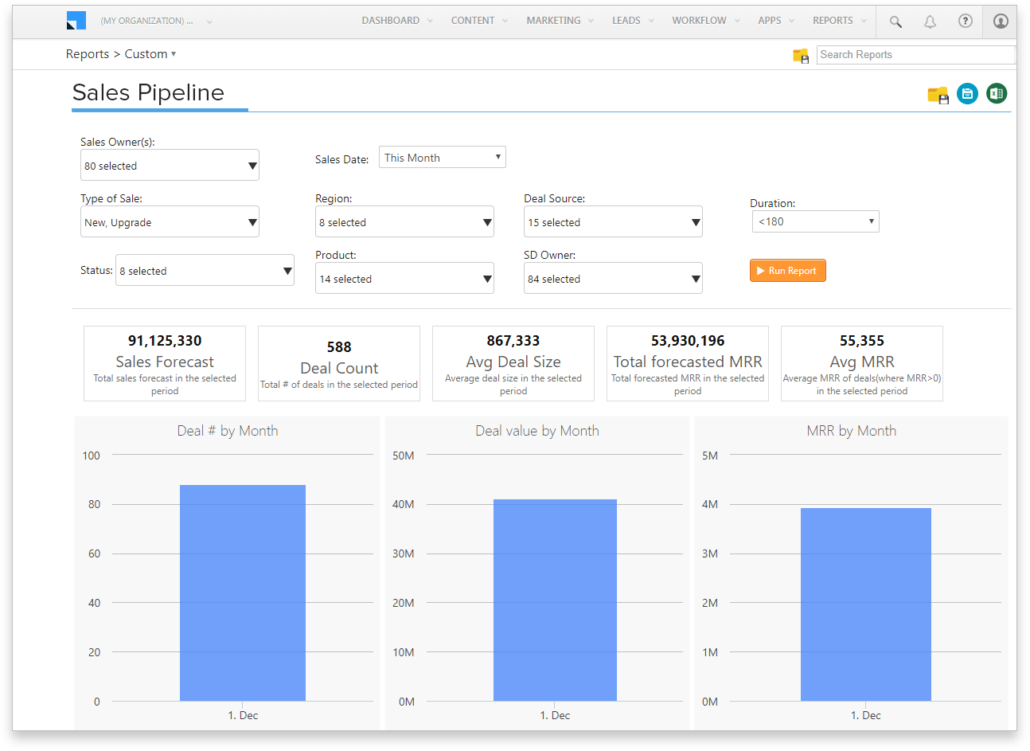
6. Speed Up Processes with Automation
The average time to close a deal is 4-6 months for new customers. To increase sales revenue, businesses need to decrease each pipeline stage’s time. LeadSquared CRM automate lead nurturing stage (with scheduled emails and reminders with marketing automation) to speed those processes. Real-time access to sales analytics data helps plan and manage multiple sales pipelines parallelly.
7. Implement a Sales Pipeline Management Tool
A sales pipeline management tool integrates all the features you need for a smooth and accurate sales pipeline. These include sales management, automation for nurturing, reminders for easy follow-ups and one-click reports.
Depending on your business’s stage or objectives, your sales pipeline management tool can be a spreadsheet or a sales automation CRM. Once you have decided your business objectives and mapped them to your sales pipeline stages, the next step is to begin the hunt for a sales pipeline management tool.
How to Choose the Best Sales Pipeline Management Tool?
Here’s a quick checklist to help you finalize a sales pipeline management tool:
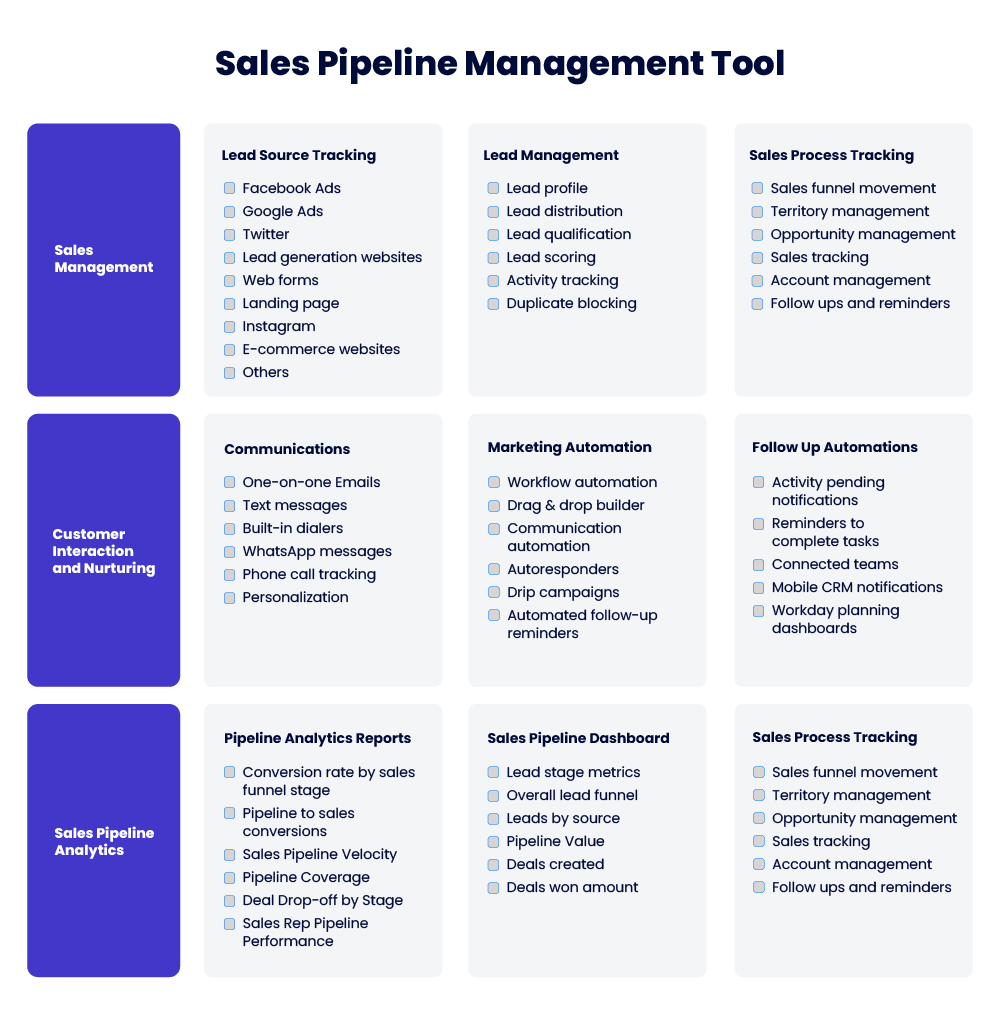
Download this checklist to share it with your sales team: Sales Pipeline Management Tool Checklist
Once you have your sales pipeline and management tool in place, your sales team can go back to carrying out their tasks while making the most out of their efforts. Here are a few benefits that you can expect as a result of sales pipeline management:
Benefits of Sales Pipeline Management
As we stated previously, a sales pipeline helps in implementing the sales process and monitoring the performances of sales teams, all these and more are further elaborated upon below:
1. Monitor the Team’s Progress
Each sales stage requires a list of actions to succeed and move on to the next. The presence and use of a sales pipeline help team managers in monitoring progress at each stage and help team members move through these stages at a rate that isn’t detrimental to the business.
2. Adequate Resource Allocation
While monitoring the various stages of a sales cycle, you, as a sales manager, can then determine what resources and in what quantities would help move a deal to the next step. Accordingly, the option to offer discounts or spontaneous incentives can be offered to speed up conversions.
3. Improve Forecasting
Sales pipelines effectively tell where each sales rep is in the sales process. Because of this, it is, therefore, easier to estimate how close teams are to reaching their target quota. This information also benefits other departments in the organization, such as finance and marketing.
4. Increase Total Sale Volumes and Revenue
The goal of every business is to make a profit, so anything that can increase the volume of sales and revenue is advised. The use of a sales pipeline does this by clearly showing which stages of the sale process produce better results and which stages may need to be completely ignored to be more productive and earn more.
Achieve these benefits with LeadSquared’s Sales CRM. Get in touch with us to learn more about LeadSquared’s capabilities.










